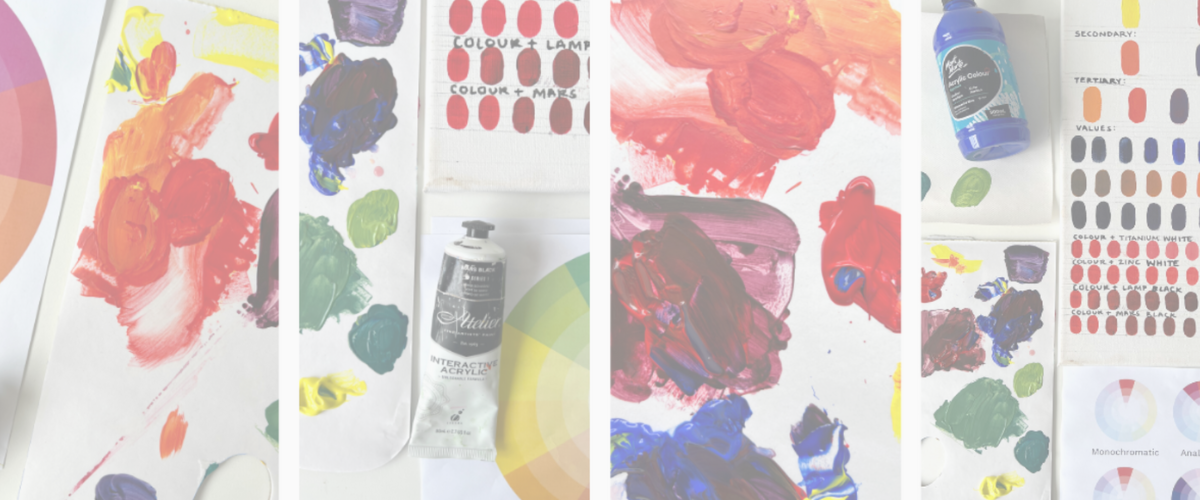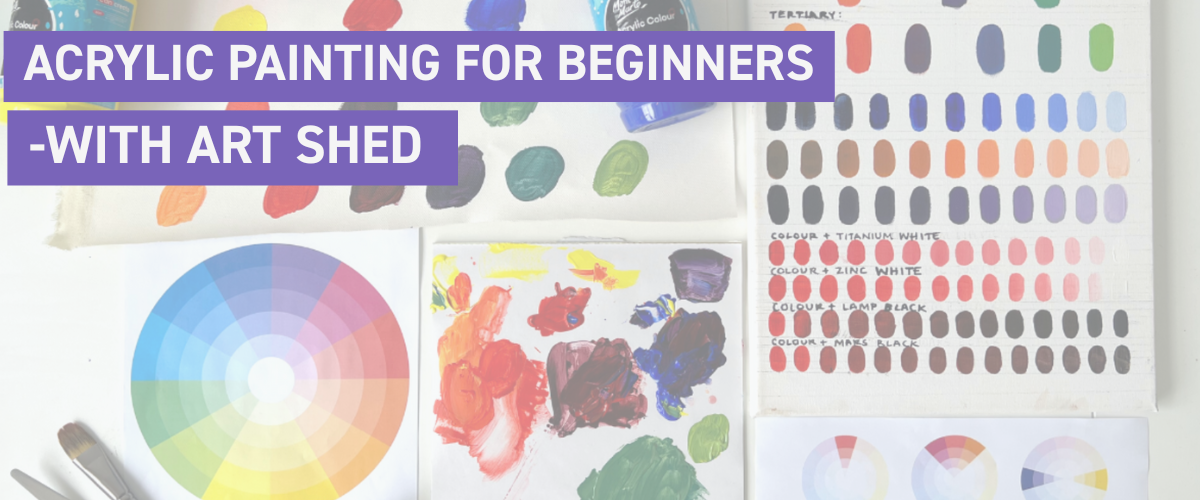The no-snob, no-stress, no-gatekeeping guide to starting your acrylic painting journey.
Thinking about getting into acrylic painting, but don’t know where to start? You’re not alone. Every month, thousands of beginner artists across Australia search for things like how to start acrylic painting, best acrylic paint for beginners, and what do I need to start acrylic painting—which is exactly why we made this guide.
This isn’t some dry lecture about colour theory. It’s a practical, step-by-step guide to everything beginner acrylic painters actually want to know. We’re talking:
What acrylic paint is (and why it’s so beginner-friendly)
What basic acrylic painting supplies you actually need
How to use acrylic paint (mixing, layering, blending, and fixing mistakes)
Tips from real Aussie artists who started just like you
A sunset painting tutorial you can do in 30 minutes
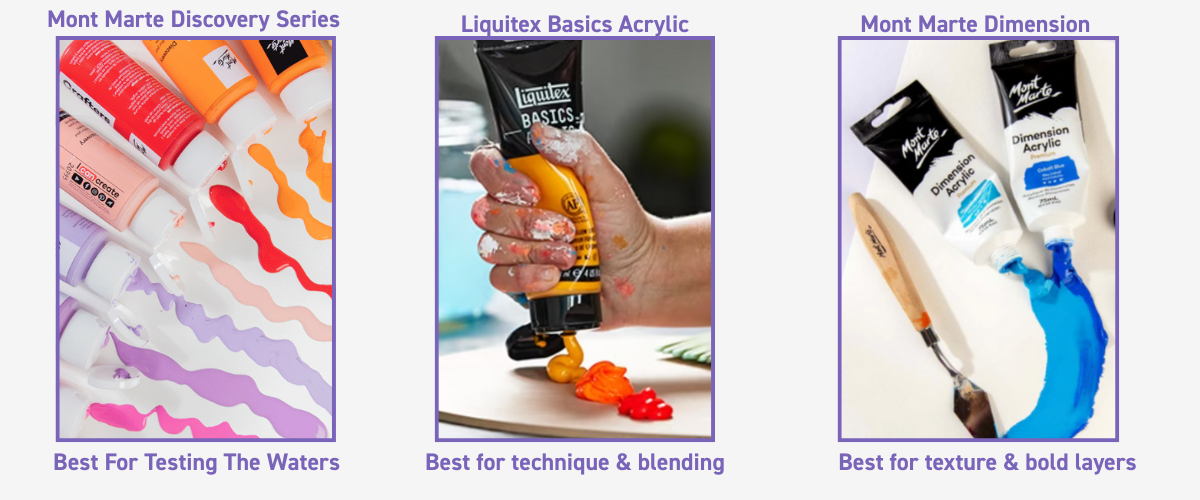
Choosing the Right Acrylic Paint
When it comes to beginner acrylic paint sets, we always recommend either Mont Marte or Liquitex Basics, but which one you pick depends on how you like to paint and what you’re hoping to get out of it.
Mont Marte Dimension is perfect if you want rich, thick, buttery paint with strong coverage and texture. It has a high pigment load and comes out of the tube ready to layer, detail, and impasto to your heart’s content. If you’re someone who likes to paint thick, bold strokes or experiment with texture straight away, this is the range for you.
Mont Marte Discovery is more budget-friendly and great for those just testing the waters. It’s a bit thinner in consistency, but still offers vibrant colour and easy use. We often recommend this for kids, schools, or first-time dabblers who aren’t ready to commit to something more premium.
Liquitex Basics, on the other hand, is a go-to for anyone who wants to learn technique. It’s smoother, creamier, and flows beautifully, making it ideal for blending, glazing, or finer brushwork. It plays especially well with mediums and has slightly more transparency options, which is great for layering. If you’re aiming for fine art style, smooth gradients, or are thinking of moving toward more advanced painting techniques, Liquitex is worth the bump in price.
Dimension gives you juicy texture and value. Liquitex gives you flow, and a solid foundation in technique. Both are great, just depends on your goals.
Want to learn more about Liquitex basics or Mont Marte dimensions? Read our artist-written blog below, filled with tips, tricks and everything you need to know to get you started
Liquitex Basics Acrylic Australia – Full Specs & Video
Why Artists Are Falling Back in Love with Mont Marte Dimension Acrylic
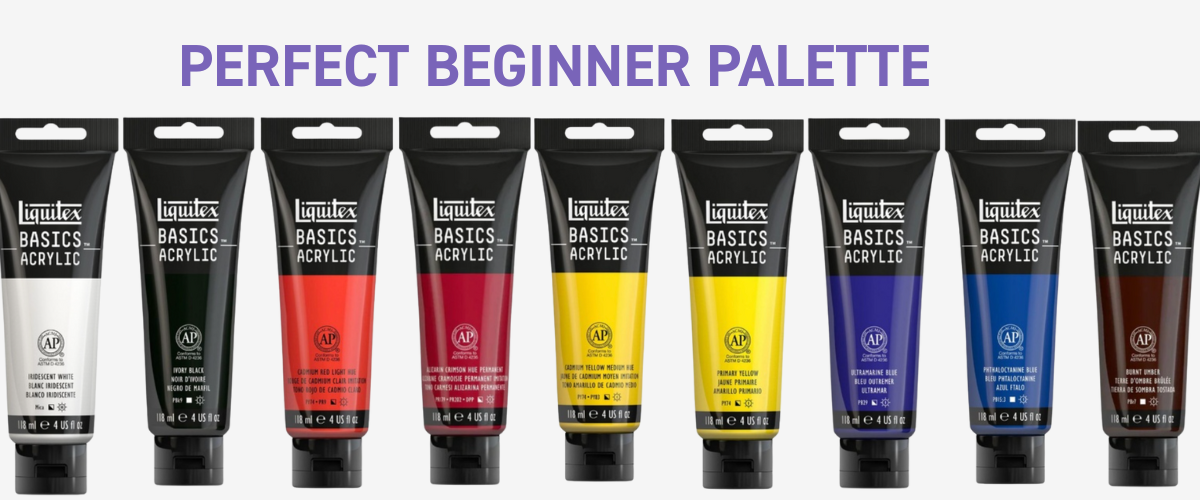
Beginner Acrylic Palette: Colours You’ll Actually Use
If you're building your first palette, don't just grab random tubes because they look pretty. You want to start with a limited mixing palette, which not only teaches you how to blend, but saves you money and shelf space. Here's the classic Art Shed starter palette and why it works.
Titanium White – for mixing tints, softening colours, and highlights
Mars Black – for deepening tones and shadows
Cadmium Red (Warm) – rich oranges, earth tones, and warm mixes
Crimson or Alizarin Crimson (Cool Red) – perfect for purples and cooler reds
Cadmium Yellow (Warm) – sunny mixes, greens, oranges
Lemon Yellow (Cool) – essential for clean greens and bright blends
Ultramarine Blue (Warm) – mixes well for earthy purples and darks
Phthalo Blue or Cerulean (Cool) – ideal for clean greens and bright skies
Burnt Umber or Yellow Ochre – for muted tones, skin colours, and landscapes
This palette gives you everything you need to mix a huge variety of colours, warm, cool, earthy or vibrant, without buying 30 individual tubes. Once you understand colour mixing, you can start adding your own flair (like a favourite green, a neon pink, or metallic gold).
If you’re not sure how to mix colours just yet, follow us on Instagram and keep your eyes peeled.
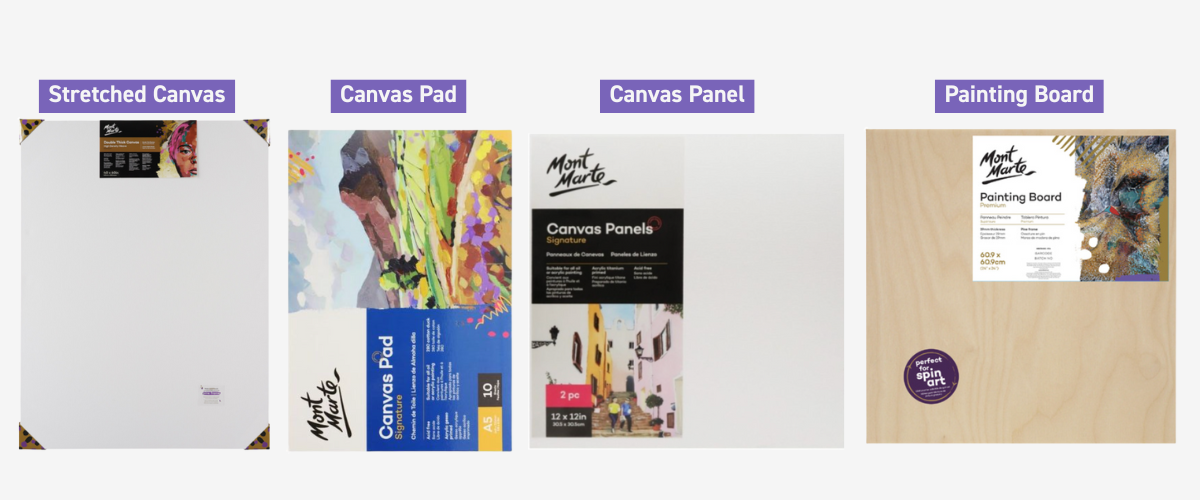
Surfaces: What to Paint On and When
Acrylics are super versatile, but each surface gives you a slightly different painting experience. Here's how to choose the right one for your style and skill level.
Canvas Pads are one of the easiest and most affordable ways to start. They’re pre-primed with acrylic gesso and give you the feel of real canvas, but on a tear-off pad you can test, experiment, or bin if things go haywire. Ideal for practice sessions, quick studies, or learning how acrylic behaves.
Stretched Canvas is great for your “serious” artworks or anything you plan to hang up or gift. It feels more professional, holds paint well, and is satisfying to work on. We recommend starting with an A3 or 40x50cm canvas, it’s big enough to give you space but not so large that it becomes overwhelming.
Canvas Boards are budget-friendly, rigid, and travel well. They’re perfect for workshops, outdoor painting, or beginner kits. The only downside? They're not as long-lasting if you're hoping to keep the work forever. But for learning, they’re a solid choice.
Wooden Boards or Panels are a fantastic choice if you want a super smooth surface and zero bounce. They’re excellent for detail work, but make sure they’re sealed or primed with gesso before painting.
Should I Sketch First? (And What Pencil Should I Use?)
If you like to plan your painting with a quick sketch, we don’t blame you; most of us do. But here’s the catch: not all pencils work well on all surfaces.
For canvas or primed surfaces, regular HB or 2B pencils can sometimes smudge or bleed through the paint, especially if you're using transparent layers. If you're sketching directly on your canvas, we recommend using a light 2H pencil, a white charcoal pencil, or even a watercolour pencil in a neutral tone that matches your paint. These are easier to cover and won’t leave muddy marks.
Keep your sketch loose. Acrylic paint is opaque and fast-drying, so you won’t need to trace every little detail. it’s easy to build as you go.
What Is Gesso and Do I Need It?
Gesso is a white, paint-like primer that prepares your surface for acrylic paint. It seals, smooths, and gives the paint something to grip to, without it, your canvas might absorb too much paint or feel a bit “scratchy.”
Most store-bought canvases and pads are already pre-primed with gesso, so you don’t have to do anything. But if you’re painting on raw wood, paper, or a DIY surface (like cardboard or fabric), a quick layer of acrylic gesso makes a world of difference. You can also add an extra coat to cheap canvases to improve the surface quality.
Want to create textured backgrounds or build up your painting base? Gesso’s got your back.
Should I Use Water or Medium with Acrylic Paint?
Water and acrylic mediums both thin out your paint, but they do it in different ways, and it’s important to understand the difference when you’re starting out.
Using water to thin acrylic paint is perfectly fine for basic techniques, light washes, and background layers. It’s easy, affordable, and gives you a smooth, slightly transparent finish. But if you add too much water, especially more than 30%, you risk breaking down the acrylic binder, which can make your colours chalky, weak, or patchy once dry.
That’s where acrylic mediums come in. Mediums are designed to thin the paint without sacrificing colour intensity or adhesion. They keep everything silky, pigmented, and stable. There are also slow-drying mediums, glazing mediums, and flow improvers that give you more working time, especially useful when you’re trying to blend a sunset or work on fine details.
Our advice? Use water for casual washes, and switch to mediums when you want better control, colour strength, or pro-level results. And whatever you choose, spray your palette with water now and then to stop it drying up mid-stroke.
.png.png)
How to Fix Mistakes in Acrylic Painting
Messing up is part of the process, and luckily, acrylics are one of the most forgiving mediums out there. If something’s not working, you don’t have to start over or rip the canvas off the wall. Just let it dry, and paint right over it.
For small fixes, a dab of opaque paint (like titanium white or burnt umber) will block out the area. Once dry, you can repaint as if nothing happened. If the texture gets chunky, you can sand it lightly with fine-grit sandpaper or blend over it using a dry-brush technique known as “scumbling.”
And if you really hate the whole thing? Cover it in gesso and start again. Some of the best artists reuse canvases this way, call it recycling with style.
The main thing is: don’t stress. Every artist has painted a lemon. Or twelve. It’s all part of the fun.
How Long Does Acrylic Paint Take to Dry?
Acrylic paint dries quickly, one of its best (and sometimes trickiest) features. Thin layers will usually be touch-dry in 10–20 minutes, depending on the weather and how much paint you’ve used. Thicker applications or heavy textures can take up to 45 minutes or more.
Keep in mind, drying time varies based on your environment. Warm, dry air and a fan will speed it up. Humidity, cold weather, or working indoors in winter will slow it right down.
Just because it feels dry to the touch doesn’t mean it’s fully cured. If you plan to varnish or frame the piece, wait at least 24 hours or even a few days if you’ve used thick paint or mediums. This ensures your colours stay locked in, and your topcoat won’t cloud or peel.
What You’ll Learn in this Video
In the sunset demo below you’ll see how to layer colour, blend transitions smoothly, capture light quickly, and apply beginner-friendly techniques to create a simple sunset in around 30 minutes. It ties together mixing, working with mediums (or water), and managing drying time so you finish with a piece that feels complete and achievable.
Acrylic FAQ with Art Shed
How do I clean my brushes properly after using acrylics?
Rinse immediately with water while the paint is still wet, then use a mild soap (or brush cleaner) to gently work out residue. Reshape the bristles and let them dry flat or bristle-down to avoid splaying.
Do I need to varnish or seal my finished acrylic painting?
Varnishing protects from dust, UV fading and evens out sheen. Wait until the piece is fully cured (at least 24–72 hours depending on thickness), then apply a removable or permanent acrylic varnish in thin even layers.
Can I use acrylics over other dried media (like pencil or pastel)?
Yes—light pencil or pastel underdrawings are fine, but heavier pastel might lift or smudge. Seal delicate underlayers with a workable fixative before painting, and test compatibility on a scrap first.
What’s the difference between acrylic and oil or watercolour paint?
Acrylics dry fast like watercolour but are more opaque and versatile; oils dry slowly and blend longer; watercolour is transparent and paper-based. Acrylics are a middle ground—blendable with mediums but quicker to layer.
How do I prevent cracking in thick acrylic layers?
Avoid applying very thick “puddle” layers all at once. Build texture in stages, letting each layer dry. Use proper acrylic mediums that flex slightly, and don’t over-thin heavy body paints with too much water.
Can I do an underpainting with acrylics?
Absolutely. Acrylic underpaintings are common—use thinned neutral tones or complementary colours to map values and composition, then layer more opaque colour on top once dry.
What’s the best way to store unfinished acrylic paintings?
Keep them in a dust-free, flat area with moderate humidity. If you’re working in stages, cover with a clean sheet or drop cloth (avoid direct contact with wet paint). For palettes, use a wet palette or mist to preserve mixed colours short-term.
Are there eco-friendlier ways to dispose of acrylic paint waste?
Let excess paint dry out on a palette or scrap and then discard solidified paint. Don’t wash large amounts down the drain; rinse brushes in minimal water and use catch trays to let pigment settle before proper disposal.
Can I mix acrylic paint with other materials like sand or fabric for texture?
Yes—acrylic is a great binder for mixed media. You can add texture mediums, sand, or embed fabric, but seal porous inclusions (like fabric) first and test adhesion. Finish with a varnish to lock everything in.
Why does my acrylic painting look dull after drying?
Some acrylics dry slightly darker or flatter. Using a gloss medium or varnish can revive vibrancy, and layering semi-transparent glazes can add depth. Also make sure you’re not overwatering, which can weaken pigment intensity.
Conclusion
This guide gives you the foundation to start acrylic painting with confidence: the right paint, palette, surfaces, and techniques to fix mistakes and manage drying. Combine what you’ve learned here with the sunset demo, get your hands dirty, and remember—it’s all about practice, experimentation, and having a bit of fun. Welcome to painting. You're officially in the Shed.
